
Pontiac was an American automobile brand owned, manufactured, and commercialized by General Motors. Introduced as a companion make for GM's more expensive line of Oakland automobiles, Pontiac overtook Oakland in popularity and supplanted its parent brand entirely by 1933.
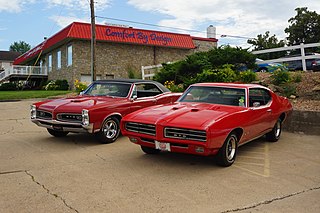
The Pontiac GTO is an automobile that was manufactured by American automaker Pontiac from 1963 to 1974 for the 1964 to 1974 model years, and by GM's subsidiary Holden in Australia for the 2004 to 2006 model years.
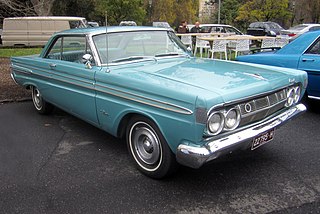
The Mercury Comet is an automobile that was produced by Mercury from 1960–1969 and 1971–1977 — variously as either a compact or an intermediate car. In its first two years, it was marketed as the "Comet" and from 1962 as the "Mercury Comet".

The Buick Skylark is a passenger car produced by Buick. The model was made in six production runs, during 46 years, over which the car's design varied dramatically due to changing technology, tastes, and new standards implemented over the years. It was named for the species of bird called skylark.

The Pontiac Firebird is an American automobile that was built and produced by Pontiac from the 1967 to 2002 model years. Designed as a pony car to compete with the Ford Mustang, it was introduced on February 23, 1967, five months after GM's Chevrolet division's platform-sharing Camaro. This also coincided with the release of the 1967 Mercury Cougar, Ford's upscale, platform-sharing version of the Mustang.
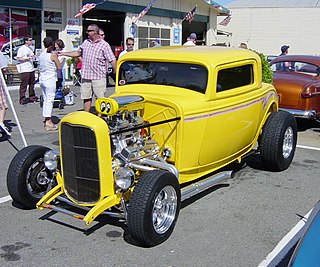
Hot rods are typically old, classic, or modern American cars that have been rebuilt or modified with large engines modified for more speed and acceleration. One definition is: "a car that's been stripped down, souped up and made to go much faster." However, there is no definition of the term that is universally accepted and the term is attached to a wide range of vehicles. Most often they are individually designed and constructed using components from many makes of old or new cars, and are most prevalent in the United States and Canada. Many are intended for exhibition rather than for racing or everyday driving.
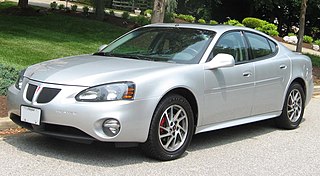
The Grand Prix is a line of automobiles produced by the Pontiac Division of General Motors from 1962 to 2002 for coupes and 1989–2008 for sedans. First introduced as part of Pontiac's full-size car model offering for the 1962 model year, the marque varied repeatedly in size, luxury, and performance during its production. Among the changes were positioning in the personal luxury car market segment and mid-size car offering from the second generation to the fifth generation for the sedan and from the second generation to the sixth generation from the coupe. The Grand Prix returned to a full-size car from the sixth generation to the seventh generation for the sedan, positioned below the larger Bonneville in Pontiac's model lineup.

The Pontiac Catalina is a full-size automobile produced by Pontiac from 1950 to 1981. Initially, the name was a trim line on hardtop body styles, first appearing in the 1950 Chieftain Eight and DeLuxe Eight lines. In 1959, it became a separate model as the "entry-level" full-size Pontiac.

The Pontiac Bonneville is an automobile built by Pontiac from 1957 to 2005. Bonnevilles were full-sized, with the exception of a brief period of mid-size between 1982–1986. The brand was introduced as a limited production performance convertible during the 1957 model year. The Bonneville, and its platform partner, the Grand Ville, are some of the largest Pontiacs ever built; in station wagon body styles they reached just over 230 inches (5.8 m) long, and at 5,000 pounds (2,300 kg) and more were also some of the heaviest cars produced at the time. They were also used as a basis for various specialty cars such as hearses.

The Pontiac Tempest is an automobile that was produced by Pontiac from 1960 to 1970, and again from 1987 to 1991.

The Ford small block is a series of 90° overhead valve small block V8 automobile engines built by the Ford Motor Company from July 1961 to 2002.
The Y-block engine is a family of overhead valve V8 automobile engines produced by Ford Motor Company. The engine is well known and named for its deep skirting, which causes the engine block to resemble a Y. It was introduced in 1954 as a more modern replacement for the outdated side-valved Ford Flathead V8 and was used in a variety of Ford vehicles through 1964.

The Pontiac V8 engine is a family of overhead valve 90° V8 engines manufactured by the Pontiac Division of General Motors Corporation between 1955 and 1981. The engine featured a cast iron block and head and 2 valves per cylinder. Engine block and cylinder heads were cast at Saginaw Metal Casting Operations then assembled at Tonawanda Engine before delivery to Pontiac Assembly for installation.

The Pontiac LeMans is a model name that was applied to subcompact- and intermediate-sized automobiles marketed by Pontiac from 1961 to 1981 model years. Originally a trim upgrade based on the Tempest, it became a separate model. In 1964 the Tempest was available with an optional GTO package that later became a separate model, the Pontiac GTO, muscle car. 1970 introduced the GT-37 package.
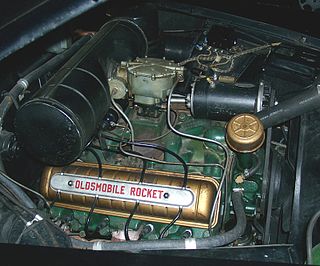
The Oldsmobile V8, also referred to as the Rocket, is series of engines that was produced by Oldsmobile from 1949 to 1990. The Rocket, along with the 1949 Cadillac V8, were the first post-war OHV crossflow cylinder head V8 engines produced by General Motors. Like all other GM divisions, Olds continued building its own V8 engine family for decades, adopting the corporate Chevrolet 350 small-block and Cadillac Northstar engine only in the 1990s. All Oldsmobile V8s were manufactured at plants in Lansing, Michigan while the engine block and cylinder heads were cast at Saginaw Metal Casting Operations.

The Pontiac Grand Am is a mid-size car and later a compact car that was produced by Pontiac. The Grand Am had two separate three-year runs in the 1970s: from 1973 to 1975, and again from 1978 to 1980. It was based on the GM A platform. Production of the Grand Am was canceled in 1980 when it was replaced by the Pontiac 6000. The Grand Am was reintroduced in 1985 when it replaced the Pontiac Phoenix. It became Pontiac's best selling car and was later replaced by the Pontiac G6, so named as it was intended to be the 6th generation of the Grand Am.

The Pontiac Ventura was an automobile model that was produced by Pontiac. As was common practice at the time, its name was derived from Ventura, California, joining other similarly derived models such as the fellow Pontiac Catalina, the Chevrolet Malibu, and Mercury Monterey.

The Mercury Meteor is an automobile that was produced by Mercury from 1961 to 1963. For 1961, the name was applied to low-end full-sized vehicles; for 1962 and 1963, the name was applied to Mercury's mid-sized sedans, in a marketing attempt to appeal to the excitement surrounding the Space Race, before being discontinued. Introduced while Mercury as a marque was in flux, and never a solid marketplace performer in consumer sales, the Meteor remains more a side note than a well known Mercury product.

The Pontiac 2+2 is a full size automobile that was manufactured by Pontiac, built on the B-body chassis. It debuted for the 1964 model year as a trim-only option for the Pontiac Catalina, with special door panels, bucket seats with a center console, and exterior badging. Pontiac marketed the 2+2 as the "big brother" to the popular Pontiac GTO.
The Oldsmobile Jetstar I is a sporty, high-performance full-sized car produced by Oldsmobile for the 1964 and 1965 model years. Based on the upscale Starfire model, the Olds 88's B-bodied Jetstar I lacked many of the Starfire's standard luxuries but shared its powerful engine, roofline and seating arrangement. Positioned to compete with Pontiac's successful full-sized Grand Prix, it was only offered as a two-door hardtop.

















